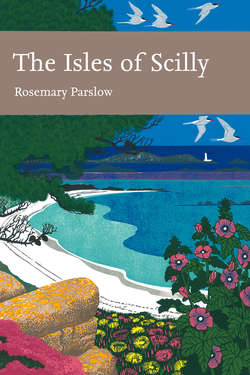Читать книгу The Isles of Scilly - Rosemary Parslow - Страница 21
GEOLOGY
ОглавлениеAT FIRST GLANCE the Ordnance Survey’s geological map of the Isles of Scilly appears to be something of a disappointment: almost the whole of the land shown on the map is coloured in the same shade of red-brown, representing granite. A granite batholith, the Cornubian batholith, extends as a series of cupolas or bosses along the Southwest Peninsula from Dartmoor to Land’s End and the Isles of Scilly, ending at the undersea mass of Haig Fras 95km further on and slightly out of line, presumably due to faulting (Edmonds et al., 1975; Selwood et al., 1998). Originally the rocks were a softer, slatey rock called killas; this was altered by pressure from the granite boss as it was extruded and pushed up into the killas, which was later eroded and now only exists as rock called tourmalised schist, found as a narrow dyke-like patch on the northwest of St Martin’s (Anon., Short Guide to the Geology of the Isles of Scilly).
The Scilly granite is very similar to that found in Cornwall, and was classified by Barrow (1906) into different types, the main ones being the older, coarse-grained G1, which is found mainly around outer the rim of the islands, and G2, which is finer-grained and is mostly in the central part of the islands and has often been intruded into G1. The two types of granite merge into each other without any obvious line of demarcation. Characteristically the granites are made up of quartz and crystals of feldspar, muscovite mica, biotite mica and other
FIG 7. Loaded Camel Rock at Porth Hellick, St Mary’s, May 2006. (Richard Green)
minerals. Much of the rock is beautifully striped through with veins and dykes, mostly narrow and usually white or black according to the infilling; white quartz or black tourmaline crystals can be found in these dykes, and rarely larger crystals of amethyst quartz. A vein of beautiful amethyst quartz that runs through some of the rocks to the north of St Agnes at one time had large, visible crystals, but most have since been taken by collectors. It is still possible to find smaller veins of crystals, and some beach pebbles have small layers of crystals running through them.
Another characteristic of the granite is the weathering along the veins and softer areas in the rock. The cooling and pressures have already formed these into very distinctive vertical and horizontal cracks, and erosion by weather and the sea then combine to produce the most extraordinary natural sculptures. Some of the most impressive examples can be seen on Peninnis Head and along the east coast of St Mary’s, but all the islands have examples. Some of these rocks have been given fanciful names: Pulpit Rock, Monk’s Cowl, Tooth Rock, Loaded Camel (Fig. 7). A curious type of formation seen frequently in Scilly is a rock basin in the top of a granite boulder where rainwater has weakened feldspar and released quartz crystals, which apparently have blown round and round to form a natural bowl.
